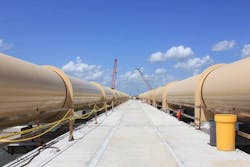Northeast Water Purification Plant (NEWPP) Expansion
Cost: $1.8 billion
Location: Humble, Texas
Year: 2021-12-21
Size: 320 mgd
Owner: Houston, Texas
North Harris County Regional Water Authority
Central Harris County Regional Water Authority
North Fort Bend Water Authority
West Harris County Regional Water Authority
Designers: Houston Waterworks Team, a Joint Venture of CDM Smith and Jacobs Engineering Group
Contractor: Houston Waterworks Team, a Joint Venture of CDM Smith and Jacobs Engineering Group
McCarthy Building Co.
Located in Humble, Texas, the Northeast Water Purification Plant (NEWPP) Expansion Project is currently the largest, progressive design-build project of its kind in the U.S.
The goal of this project is to increase surface water usage and dramatically reduce south Texas’ dependence on groundwater. The NEWPP Expansion Project includes design, construction, and commissioning of an intake pump station; twin 108-inch transmission mains; pre- and post-treatment chemical addition; flocculation and sedimentation basins; ozone treatment; filtration; finished water storage tanks; and two high-service pumping stations.
Groundwater is the primary source for drinking water in south Texas, but over the years, extensive drilling into the aquifers has depleted reserves and caused subsidence. As such, the Houston-Galveston region is one of the largest subsidence areas in the U.S., which compromises its ability to store water in aquifers and jeopardizes the integrity of infrastructure such as roadways, bridges, and building foundations. The issue also exacerbates regional flooding, particularly due to heavy seasonal rain associated with hurricanes and tropical storms.
The project includes liquid residuals basins, gravity thickeners, and a dewatering building with centrifuges. NEWPP expands the existing plant’s 80 mgd capacity by an additional 320 mgd for a new total of 400 mgd, which can be expanded in the future to 560 mgd.
The Surface Water Supply Project (SWSP) was created in the 2000s by the West Harris County Regional Water Authority (WHCRWA) and the North Fort Bend Water Authority (NFBWA). SWSP aims to replace groundwater with lake and river water to reduce groundwater usage by 80% by 2035.
Overall, NEWPP is a collaboration between the city of Houston, North Harris County Regional Water Authority, WHCRWA, NFBWA, and Central Harris County Regional Water Authority. The Houston Waterworks Team (HWT - a joint venture of CDM Smith and Jacobs Engineering Group) is the design-build contractor responsible for designing and constructing the overall project.
The Luce Bayou Interbasin Transfer Project (LBITP), a recently completed component of the SWSP, is essential to the overall surface water delivery program. The LBITP will convey up to 500 mgd of untreated surface water from the Trinity River through 23 miles of pipelines and open canals to an outfall structure at Lake Houston for eventual treatment at NEWPP.
The new Intake Pump Station will withdraw raw water from Lake Houston and will pump the raw water via pipelines to the main plant site for treatment. The new Intake Pump Station is located in Lake Houston, 1,000 feet away from the shoreline and is accessible via a bridge. It is built on a driven pile-supported platform and is outfitted with six pumps (expandable to 10 pumps) that withdraw and feed raw water from the lake into dual 108-inch transmission pipelines that carry the raw water over the lake to shore. The Intake Pump Station includes underwater fish screens, pumping, and conveyance to withdraw water from the lake and deliver it to the treatment facilities located 1.5 miles inland.
After the raw water is treated at NEWPP Expansion to produce drinking water, it will be transported by pumping through more than 55 miles of pipeline across the greater Houston area.
Lake Houston is shallow and is in an area where flooding is prevalent, so the raw water source itself presented challenges during design.
During heavy rain events, the lake can be completely flushed as many as 12 times per day, with each instance resulting in changes to turbidity, pH, alkalinity, and organic levels. The new Intake Pump Station is designed to withdraw raw water from a slightly greater depth than the original pump station to reduce the impact of local storm water discharges from canals such as Jack’s Ditch. The new facilities for coagulation, flocculation and sedimentation at the main plant site will process the raw water to remove inert solids and about half of the total organic carbon, after which, plate settlers will be used for further removal of solids.
In the next step, ozone, a powerful oxidant, will be diffused into the water to treat the settled water for primary disinfection and destruction of taste and odor-causing compounds. The ozone also will further break down residual organic matter so it can be more readily assimilated by the two biologically active 2,300-sq-ft filters downstream. This is the first time that the ozonation process will be used for this purpose in Houston.
Installation conditions also posed worker safety challenges. Additional training and special personal protective equipment were required for crews who were working over water, and because NEWPP was ongoing during the pandemic, extra precautions were taken to avoid unnecessary personnel interaction.
Approximately 3 million people will receive drinking water from the new plant.
Project Year: 2021-12-21Contractor: Houston Waterworks Team, a Joint Venture of CDM Smith and Jacobs Engineering Group McCarthy Building Co.Designers: Houston Waterworks Team, a Joint Venture of CDM Smith and Jacobs Engineering GroupOwner: Houston, Texas North Harris County Regional Water Authority Central Harris County Regional Water Authority North Fort Bend Water Authority West Harris County Regional Water AuthorityLocation: Humble, TexasCost: $1.8 billionSize: 320 mgd